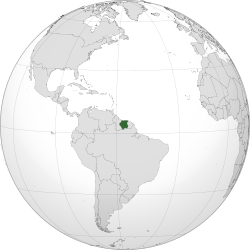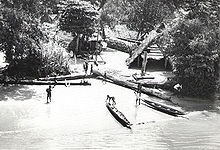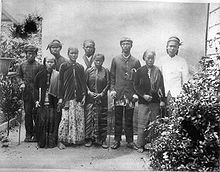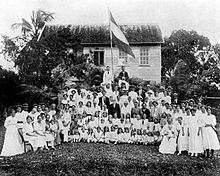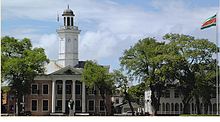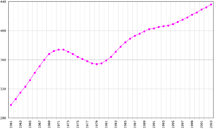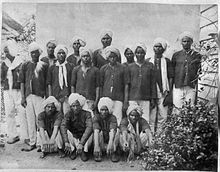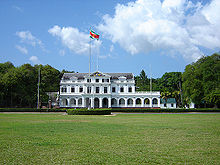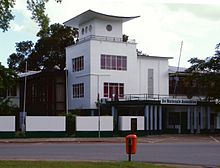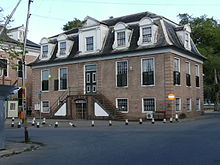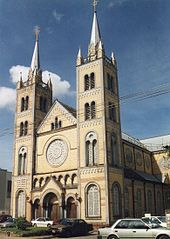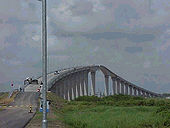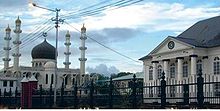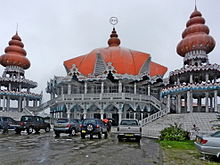
Suriname
Background to the schools Wikipedia
SOS Children offer a complete download of this selection for schools for use on schools intranets. Visit the SOS Children website at http://www.soschildren.org/
| Republic of Suriname Republiek Suriname (Dutch)
|
||||||
|---|---|---|---|---|---|---|
|
||||||
| Motto: "Justitia – Pietas – Fides" (Latin) "Justice – Duty – Loyalty" |
||||||
| Anthem: God zij met ons Suriname (Dutch) God be with our Suriname |
||||||
|
|
||||||
| Capital and largest city |
Paramaribo 5°50′N 55°10′W |
|||||
| Official languages | Dutch | |||||
| Ethnic groups (2004) |
|
|||||
| Demonym | Surinamese | |||||
| Government | Unitary presidential constitutional republic | |||||
| - | President | Dési Bouterse | ||||
| - | Vice-President | Robert Ameerali | ||||
| Legislature | National Assembly | |||||
| Independence | ||||||
| - | from the Netherlands | 25 November 1975 | ||||
| - | Current constitution | 30 September 1987 | ||||
| Area | ||||||
| - | Total | 163,821 km2 ( 92nd) 63,251 sq mi |
||||
| - | Water (%) | 1.1 | ||||
| Population | ||||||
| - | 2012 estimate | 560,157 ( 167th) | ||||
| - | 2004 census | 492,829 | ||||
| - | Density | 2.9/km2 ( 231st) 7.6/sq mi |
||||
| GDP ( PPP) | 2011 estimate | |||||
| - | Total | $5.060 billion | ||||
| - | Per capita | $9,475 | ||||
| GDP (nominal) | 2011 estimate | |||||
| - | Total | $3.790 billion | ||||
| - | Per capita | $7,096 | ||||
| HDI (2012) | medium · 104th |
|||||
| Currency | Surinamese dollar ( SRD) |
|||||
| Time zone | ART ( UTC-3) | |||||
| - | Summer ( DST) | not observed ( UTC-3) | ||||
| Drives on the | left | |||||
| Calling code | +597 | |||||
| ISO 3166 code | SR | |||||
| Internet TLD | .sr | |||||
Suriname (or Surinam), officially known as the Republic of Suriname (Dutch: Republiek Suriname, Dutch pronunciation: [ˌrepyˈblik ˌsyriˈnaːmə]), is a country in northern South America. It is bordered by French Guiana to the east, Guyana to the west, Brazil to the south and the Atlantic Ocean to the north, making it one of two countries, French Guiana the other, not to border any of the Spanish-speaking countries on the continent. Suriname was colonised by the English and the Dutch in the 17th century.
In 1667 it was captured by the Dutch, who governed Suriname as Dutch Guiana until 1954. At that time it was designated as one of the constituent countries (Dutch: landen) of the Kingdom of the Netherlands, next to the the Netherlands and the Netherlands Antilles (dissolved in 2010). On 25 November 1975, the country of Suriname left the Kingdom of the Netherlands to become independent. A member of CARICOM, it is frequently considered a Caribbean country and has had frequent trade and cultural exchange with the Caribbean nations.
At just under 165,000 km2 (64,000 sq mi), Suriname is the smallest sovereign state in South America. (French Guiana, while less extensive and populous, is an overseas department of France.) Suriname has a population of approximately 560,000, most of whom live on the country's north coast, where the capital Paramaribo is located. The official language is Dutch. It is the only independent entity in the Americas where Dutch is spoken.
Etymology
The name Suriname may derive from a Taino ( Arawak-speaking) group called Surinen, who occupied the region before European arrival.
English settlers, who founded the first European colony at Marshall's Creek along the Suriname River, spelled the name as "Surinam". Taken over by the Dutch, it became part of a group of colonies known as Dutch Guiana. Surinam can still be found in English. A notable example is Suriname's national airline, Surinam Airways. The older English name is reflected in the English pronunciation, / ˈ s ʊr ɨ n æ m / or / ˈ s ʊr ɨ n ɑː m /. In Dutch, the official language of Suriname, the pronunciation is [ˌsyriˈnaːmə], with the main stress on the third syllable and a schwa terminal vowel.
Geography
Suriname is the smallest independent country in South America. Situated on the Guiana Shield, it lies mostly between latitudes 1° and 6°N, and longitudes 54° and 58°W. The country can be divided into two main geographic regions. The northern, lowland coastal area (roughly above the line Albina-Paranam-Wageningen) has been cultivated, and most of the population lives here. The southern part consists of tropical rainforest and sparsely inhabited savanna along the border with Brazil, covering about 80% of Suriname's land surface.
The two main mountain ranges are the Bakhuys Mountains and the Van Asch Van Wijck Mountains. Julianatop is the highest mountain in the country at 1,286 metres (4,219 ft) above sea level. Other mountains include Tafelberg at 1,026 metres (3,366 ft), Mount Kasikasima at 718 metres (2,356 ft), Goliathberg at 358 metres (1,175 ft) and Voltzberg at 240 metres (790 ft).
Borders
Suriname is situated between French Guiana to the east and Guyana to the west. The southern border is shared with Brazil and the northern border is the Atlantic coast. The southernmost borders with French Guiana and Guyana are disputed by these countries along the Marowijne and Corantijn rivers, respectively, while a part of the disputed maritime boundary with Guyana was arbitrated by a tribunal convened under the rules set out in Annex VII of the United Nations Convention on the Law of the Sea on 20 September 2007.
Districts and resorts
Suriname is divided into ten districts:
|
Suriname is further subdivided into 62 resorts (ressorten).
Climate
Lying 2 to 5 degrees north of the equator, Suriname has a very hot tropical climate, and temperatures do not vary much throughout the year. Average relative humidity is between 80% and 90%. Its average temperature ranges from 84 to 97 degrees Fahrenheit (29 to 34 degrees Celsius). Due to the high humidity, actual temperatures are distorted and may therefore feel up to 11 degrees Fahrenheit (6 degrees Celsius) hotter than the recorded temperature. The year has two wet seasons, from April to August and from November to February. It also has two dry seasons, from August to November and February to April.
Nature reserves
In the upper Coppename River watershed, the Central Suriname Nature Reserve is a UNESCO World Heritage Site cited for its unspoiled forests biodiversity. There are many national parks in the country: Galibi National Reserve, Coppename Manding National Park and Wia Wia NR along the coast, Brownsberg NR, Raleighvallen/Voltzeberg NR, Tafelberg NR and Eilerts de Haan NP in the centre and the Sipaliwani NR on the Brazilian border. In all, 12.6% of the country's land area are national parks and lakes, according to the UNEP World Conservation Monitoring Centre.
History
Colonial period
Beginning in the 16th century, French, Spanish, and English explorers visited the area. A century later, plantation colonies were established by the Dutch and English along the many rivers in the fertile Guiana plains. The earliest documented colony in Guiana was an English settlement named Marshall's Creek along the Suriname River. Disputes arose between the Dutch and the English. In 1667, the Dutch decided to keep the nascent plantation colony of Suriname conquered from the English, resulting from the Treaty of Breda. The English were left with New Amsterdam, a small trading post in North America, which later became New York City.
In 1683, the Society of Suriname was founded by the city of Amsterdam, the Van Aerssen van Sommelsdijck family, and the Dutch West India Company. The society was chartered to manage and defend the colony. The planters of the colony relied heavily on African slaves to cultivate the coffee, cocoa, sugar cane and cotton plantations along the rivers. Planters' treatment of the slaves was notoriously bad, and many slaves escaped the plantations.
With the help of the native South Americans living in the adjoining rain forests, these runaway slaves established a new and unique culture that was highly successful in its own right. They were known collectively in English as the Maroons, in French as the Nèg'Marrons (literally meaning "maroon neg[roes]", that is "runaway negro slaves"), and in Dutch as Bosnegers (literally meaning "forest negroes"). The maroons gradually developed several independent tribes through a process of ethnogenesis, as they were made up of slaves from different African ethnicities. Among them are the Saramaka, the Paramaka, the Ndyuka or Aukan, the Kwinti, the Aluku or Boni, and the Matawai.
The Maroons often raided the plantations to recruit new members from the slaves and capture women, as well as acquire weapons, food and supplies. The planters and their families were sometimes killed in the raids; colonists built defenses, which were so important they were shown on 18th-century maps, but these were not sufficient. The colonists also mounted armed campaigns against the Maroons, but they generally escaped through the rainforest, which they knew much better than did the colonists. To end hostilities, in the 19th century the European colonial authorities signed several peace treaties with different tribes. They granted the Maroons sovereign status and trade rights in their inland territories.
Abolition of slavery
Slavery was abolished by the Netherlands in Suriname in 1863, but the slaves in Suriname were not fully released until 1873, after a mandatory 10 year transition period during which time they were required to work on the plantations for minimal pay and without state sanctioned discipline. As soon as they became truly free, the slaves largely abandoned the plantations where they had worked for several generations, in favour of the city, Paramaribo.
As a plantation colony, Suriname was still heavily dependent on manual labour, and to make up for the shortfall, the Dutch brought in contract labourers from the Dutch East Indies (modern Indonesia) and India (through an arrangement with the British). In addition, during the late 19th and early 20th centuries, small numbers of mostly men were brought in from China and the Middle East. Although Suriname's population remains relatively small, because of this history it is one of the most ethnically and culturally diverse countries in the world.
On 23 November 1941, under an agreement with the Netherlands government-in-exile, the United States occupied Suriname to protect bauxite mines. In 1954, Suriname became one of the constituent countries of the Kingdom of the Netherlands, along with the Netherlands Antilles and the Netherlands. In this construction, the Netherlands retained control of defense and foreign affairs. In 1973, the local government, led by the NPK (a largely Creole, meaning ethnically African or mixed African-European, party) started negotiations with the Dutch government leading towards full independence, which was granted on 25 November 1975. The severance package was very substantial, and a large part of Suriname's economy for the first decade following independence was fueled by foreign aid provided by the Dutch government.
Independence
The first President of the country was Johan Ferrier, the former governor, with Henck Arron (the then leader of the Nationale Partij Suriname (Suriname's National Party) as Prime Minister. In the years leading up to independence nearly one-third of the population of Suriname emigrated to the Netherlands, amidst concern that the new country would fare worse under independence than it had as an overseas colony of the Netherlands. Suriname's diaspora includes more than a quarter of a million people of Surinamese origin currently living in the Netherlands, including several recent members of the Dutch national football team.
December killings
On 25 February 1980, a military coup overthrew the democratic government and declared a socialist republic. Between 2am and 5am on the morning of 7 December 1982, the military, under the leadership of Dési Bouterse, rounded up 15 prominent citizens who had criticized the military dictatorship in Suriname, and brought them to Fort Zeelandia. They were executed over the next three days, and the Netherlands quickly suspended all foreign aid to Suriname. Bouterse is being tried for the murders, but the Suriname parliament has passed a law that grants Bouterse amnesty for the alleged violations. The Dutch government has stated that stopping the trial would be "totally unacceptable". Bouterse has been convicted in absentia in the Netherlands on drug smuggling charges.
Elections were held in 1987, and a new constitution was adopted that, among other things, allowed Bouterse to remain in charge of the army. Dissatisfied with the government, Bouterse summarily dismissed them in 1990, by telephone. This event became popularly known as the "Telephone Coup". His power began to wane after the 1991 elections; an ongoing brutal civil war between the Suriname army and Maroons loyal to rebel leader Ronnie Brunswijk, begun in 1986, further weakened Bouterse's position during the 1990s.
Seeing the deterioration of the situation, Aruba, the Netherlands Antilles and the Netherlands considered inviting the country to rejoin the Netherlands as an "associated state" in 1991.
2009 Albina Riots
Violent riots broke out in Albina in 2009 between the local Maroon population and Brazilian gold diggers.
Economy
Suriname's democracy gained some strength after the turbulent 1990s, and its economy became more diversified and less dependent on Dutch financial assistance. Bauxite (aluminium ore) mining continues to be a strong revenue source, and the discovery and exploitation of oil and gold has added substantially to Suriname's economic independence. Agriculture, especially rice and bananas, remains a strong component of the economy, and ecotourism is providing new economic opportunities. More than 80% of Suriname's land-mass consists of unspoiled rain forest; with the establishment of the Central Suriname Nature Reserve in 1998, Suriname signalled its commitment to conservation of this precious resource. The Central Suriname Nature Reserve became a World Heritage Site in 2000.
The economy of Suriname is dominated by the bauxite industry, which accounts for more than 15% of GDP and 70% of export earnings. Other main export products include rice, bananas and shrimp. Suriname has recently started exploiting some of its sizeable oil and gold reserves. About a quarter of the people work in the agricultural sector. The Surinamese economy is very dependent on commerce, its main trade partners being the Netherlands, the United States, Canada, and Caribbean countries, mainly Trinidad and Tobago and the former islands of the Netherlands Antilles.
After assuming power in the fall of 1996, the Wijdenbosch government ended the structural adjustment program of the previous government, claiming it was unfair to the poorer elements of society. Tax revenues fell as old taxes lapsed and the government failed to implement new tax alternatives. By the end of 1997, the allocation of new Dutch development funds was frozen as Surinamese Government relations with the Netherlands deteriorated. Economic growth slowed in 1998, with decline in the mining, construction, and utility sectors. Rampant government expenditures, poor tax collection, a bloated civil service, and reduced foreign aid in 1999 contributed to the fiscal deficit, estimated at 11% of GDP. The government sought to cover this deficit through monetary expansion, which led to a dramatic increase in inflation. It takes longer on average to register a new business in Suriname than virtually any other country in the world (694 days or about 99 weeks).
- GDP (2010 est.): U.S. $4.794 billion.
- Annual growth rate real GDP (2010 est.): 3.5%.
- Per capita GDP (2010 est.): U.S. $9,900.
- Inflation (2007): 6.4%.
- Natural resources: Bauxite, gold, oil, iron ore, other minerals; forests; hydroelectric potential; fish and shrimp.
- Agriculture: Products—rice, bananas, timber, palm kernels, coconuts, peanuts, citrus fruits, and forest products.
- Industry: Types—alumina, oil, gold, fish, shrimp, lumber.
- Trade (2005):
- Exports: $1.391 billion: alumina, gold, crude oil, lumber, shrimp and fish, rice, bananas. Major consumers: Canada 35.47%, Belgium 14.92%, US 10.15%, UAE 9.87%, Norway 4.92%, Netherlands 4.7%, France 4.47% (2009)
- Imports: $1.297 billion: capital equipment, petroleum, foodstuffs, cotton, consumer goods. Major suppliers: US 30.79%, Netherlands 19.17%, Trinidad and Tobago 13.04%, China 6.8%, Japan 5.85% (2009).
Demographics
According to the 2004 census, Suriname had a population of 492,829 inhabitants. It is made up of several distinct ethnic groups.
- Amerindians, the original inhabitants of Suriname, form 3.7% of the population. The main groups being the Akuriyo, Arawak, Carib/ Kaliña, Trío ( Tiriyó), and Wayana. They live mainly in the districts of Paramaribo, Wanica, Maroni and Sipaliwini.
- Hindustani form the largest major group at 37% of the population. They are descendants of 19th-century contract workers from India. They are from the Indian states of Bihar and Eastern Uttar Pradesh, in Northern India, along the Nepali border.
- The Surinamese Creoles form the middle group 31% of the population. They are the mixed descendants of West African slaves and Europeans (mostly Dutch).
- The Javanese (descendants of contract workers from the former Dutch East Indies on the island of Java, Indonesia), form 15% of the population. mainly in Nickerie, Saramacca, Wanica, Paramaribo and Commewijne
- Surinamese Maroons (descendants of escaped West African slaves) make up 10% and are divided into five main groups: Ndyuka (Aucans), Kwinti, Matawai, Saramaccans and Paramaccans.
- Chinese, about 14,000 are descendants of the earliest 19th-century contract workers. The 1990s and early 21st century saw renewed immigration on a large scale. In the year 2011 there were over 40,000 Chinese in Suriname, including legal and illegal migrants.
- Europeans, descendants of Dutch 19th-century immigrant farmers, Portuguese from Madeira and other European peoples. The descendants of Dutch immigrant farmers are known as "Boeroes" (derived from boer, the Dutch word for "farmer"). Most Boeroes left after independence in 1975.
- Jews, mainly descendants of Sephardic Jews, but also Ashkenazi Jews. In their history, Jodensavanne plays a major role. Many Jews are mixed with other populations.
- Lebanese, (primarily Maronites) from the town of Bsharri, Lebanon.
- Brazilians, many of them gold miners. Most of the nearly 40,000 Brazilians living in Suriname arrived during the past several years.
The vast majority of people (about 90%) live in Paramaribo or on the coast. There is also a significant Surinamese population in the Netherlands. In 2005 there were 328,300 Surinamese people living in the Netherlands, which is about 2% of the total population of the Netherlands, compared to 438,000 Surinamese in Suriname itself.
Religion
The predominant religion in the country is Christianity, both in the form of Roman Catholicism and various denominations of Protestantism, the Moravian Church being the oldest and largest. It is particularly dominant among Creoles and Maroons. The Creoles and to a lesser degree the Maroons, both predominantly descended from enslaved Africans, converted to Christianity during the colonial period but may still retain their Afro-American religion called Winti. The Indian descended population practice Hindu, Islam or Christianity. The Javanese practice either Islam or Christianity. Suriname's population is 19.6% Muslim.
Languages
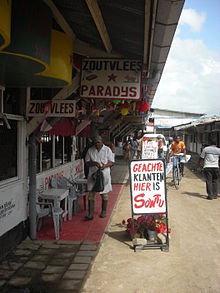
Dutch is the sole official language, and is the language of education, government, business, and the media. Over 60% of the population speak Dutch as a mother tongue, and most of the rest speak it as a second language. In 2004 Suriname became an associate member of the Dutch Language Union. It is the only Dutch-speaking country in South America well as the only independent nation in the Americas where Dutch is spoken, and one of the two non- Romance-speaking countries on the continent, the other being English-speaking Guyana.
In Paramaribo, Dutch is the main home language in two-thirds of households. The recognition of "Surinaams-Nederlands" (" Surinamese Dutch") as a national dialect equal to "Nederlands-Nederlands" ("Dutch Dutch") and "Vlaams-Nederlands" ("Flemish Dutch") was expressed in 2009 by the publication of the Woordenboek Surinaams Nederlands (Surinamese–Dutch Dictionary). Only in the interior of Suriname is Dutch seldom spoken.
Sranan Tongo, a local creole language originally spoken by the creole population group, is the most widely used language in the streets and often interchangeably with Dutch depending on the formality of the setting.
Surinamese Hindi or Sarnami, a dialect of Bhojpuri, is the third-most used language, spoken by the descendants of South Asian contract workers from then British India. Javanese is used by the descendants of Javanese contract workers. The Maroon languages, somewhat intelligible with Sranan Tongo, include Saramaka, Paramakan, Ndyuka (also called Aukan), Kwinti and Matawai. Amerindian languages, spoken by Amerindians, include Carib and Arawak. Hakka and Cantonese are spoken by the descendants of the Chinese contract (koelie, coolie) workers. Mandarin is spoken by some few recent Chinese immigrants. English, Spanish and Portuguese are also used. Spanish and Portuguese are spoken by Latin American residents and their descendants and sometimes also taught in schools.
The public discourse about Suriname's languages is a part of an ongoing debate about the country's national identity. While Dutch is perceived as a remnant of colonialism by some, the use of the popular Sranan became associated with nationalist politics after its public use by former dictator Dési Bouterse in the 1980s, and groups descended from escaped slaves might resent it. Some propose to change the national language to English, so as to improve links to the Caribbean and North America, or to Spanish, as a nod to Suriname's location in South America, although it has no Spanish-speaking neighbours.
Health
The fertility rate was at 2.6 births per woman. Public expenditure was at 3.6% of the GDP in 2004, whereas private expenditure was at 4.2%. There were 45 physicians per 100,000 in the early 2000s. Infant mortality was at 30 per 1,000 live births. Male life expectancy at birth was at 66.4 years, whereas female life expectancy at birth was at 73 years.
Transport
Suriname and neighboring Guyana are the only two countries on the (in-land) South American continent that drive on the left. In Guyana, this practice is inherited from United Kingdom colonial authorities. The reason that Suriname drives on the left is explained by several sources. It is thought that this is because the first cars imported were from England, but this is yet undocumented. In addition, this view does not make statements on traffic before the automobile era. Another explanation is that the Netherlands, at the time of colonization of Suriname, used the left-hand side of the road for traffic, or that Suriname was first colonized by the English. Although the Netherlands converted to driving to the right at the end of the 18th century), Suriname did not. Writers Peter Kincaid and Ian Watson suggest that in territories such as Suriname, with no connecting roads to neighbour countries, there is no external pressure to either change or to maintain the status quo on driving sides.
Largest cities
| Largest cities or towns of Suriname http://www.geonames.org/SR/largest-cities-in-suriname.html |
|||||||||
|---|---|---|---|---|---|---|---|---|---|
| Rank | City name | District | Pop.
|
||||||
| 1 | Paramaribo | Paramaribo | 223 757 | ||||||
| 2 | Lelydorp | Wanica | 18 223 | ||||||
| 3 | Nieuw Nickerie | Nickerie | 13 143 | ||||||
| 4 | Moengo | Marowijne | 7 074 | ||||||
| 5 | Nieuw Amsterdam | Commewijne | 4 935 | ||||||
| 6 | Mariënburg | Commewijne | 4 427 | ||||||
| 7 | Wageningen | Nickerie | 4 145 | ||||||
| 8 | Albina | Marowijne | 3 985 | ||||||
| 9 | Groningen | Saramacca | 3 216 | ||||||
| 10 | Brownsweg | Brokopondo | 2 696 | ||||||
Politics
The Republic of Suriname is a constitutional, democratically representational republic based on the 1987 constitution. The legislative branch of government consists of a 51-member unicameral National Assembly, simultaneously and popularly elected for a five-year term.
In the most recent elections, held on Tuesday, 25 May 2010 the "Megacombinatie" won 23 of the National Assembly seats followed by "Nationale Front" with 20 seats. A much smaller number, important for coalition-building, went to the "A‑combinatie" and to the "Volksalliantie". Negotiations are ongoing between parties regarding the formation of coalitions.
The President of Suriname, who is elected for a five-year term by a two-thirds majority of the National Assembly or, failing that, by a majority of the People's Assembly, heads the executive branch. If at least two-thirds of the National Assembly cannot agree to vote for one presidential candidate, a People's Assembly is formed from all National Assembly delegates and regional and municipal representatives who were elected by popular vote in the most recent national election. As head of government, the president appoints a sixteen-minister cabinet. A vice president, normally elected at the same time as the president, needs a simple majority in the National Assembly or People's Assembly to be elected for a five-year term. There is no constitutional provision for removal or replacement of the president unless he resigns.
The judiciary is headed by the Court of Justice (Supreme Court). This court supervises the magistrate courts. Members are appointed for life by the president in consultation with the National Assembly, the State Advisory Council and the National Order of Private Attorneys. In April 2005, the regional Caribbean Court of Justice, based in Trinidad, was inaugurated. As the final court of appeal, it was intended to replace the London-based Privy Council.
The country is divided into ten administrative districts, each headed by a district commissioner appointed by the president, who also has the power of dismissal.
Environmental Preservation
On March 21, 2013 Suriname's REDD+ Readiness Preparation Proposal (R-PP 2013) was approved by the member countries of the Participants Committee of the Forest Carbon Partnership Facility (FCPF). Member countries include Australia, Canada, Denmark, Finland, France, Germany, Italy, Japan, Netherlands, Norway, Spain, Switzerland, UK, USA and the European Commission.
Tourism
Royal Torarica, was opened in the night district of Paramaribo on the Suriname River. The hotel industry is important to Suriname's economy. The rental of apartments, or the rent-a-house phenomenon, is also popular in Suriname.
Most tourists visit Suriname for the outstanding biodiversity of the pristine Amazonian rain forests in the south of the country, which are noted for their flora and fauna. The Central Suriname Nature Reserve is the biggest and one of the most popular reserves, along with the Brownsberg Nature Park which overlooks the Brokopondo Reservoir, the latter being one of the largest man-made lakes in the world. Tonka Island in the reservoir is home to a rustic eco-tourism project run by the Saramaccaner Maroons. Pangi wraps and bowls made of calabashes are the two main products manufactured by maroons for tourists. The maroons have learned that colorful and ornate pangis are the most popular with tourists.
There are also many waterfalls throughout the country. Raleighvallen, or Raleigh Falls, is a 56,000-hectare (140,000-acre) nature reserve on the Coppename River, rich in bird life. Also are the Blanche Marie Falls on the Nickerie River and the Wonotobo Falls. Tafelberg Mountain in the centre of the country is surrounded by its own reserve – the Tafelberg Nature Reserve – around the source of the Saramacca River, as is the Voltzberg Nature Reserve further north on the Coppename River at Raleighvallen. In the interior are many Maroon and Amerindian villages many of which have their own reserves, generally open to visitors.
Suriname is one of the few countries in the world where at least one of each biome that the state possesses has been declared a wildlife reserve. Around 30% of the total land area of Suriname is protected by law as reserves.
Other attractions include plantations such as Laarwijk, which is situated along the Suriname River. This plantation can only be reached by boat via Domburg, in the north central Wanica District of Suriname.
Landmarks
The Jules Wijdenbosch Bridge is a bridge over the river Suriname between Paramaribo and Meerzorg in the Commewijne district. The bridge was built during the tenure of President Jules Albert Wijdenbosch (1996–2000) and was completed in 2000. The bridge is 52 metres (171 ft) high, and 1,504 metres (4,934 ft) long. It connects Paramaribo with Commewijne, a connection which previously could only be made by ferry. The purpose of the bridge was to facilitate and promote the development of the eastern part of Suriname. The bridge consists of two lanes (one lane each way) and is accessible to pedestrians.
The Cathedral of Sts. Peter and Paul is 114 years old. Before it became a cathedral it was a theatre. The theatre was built in 1809 and burned down in 1820. The construction of the Sts. Peter and Paul Cathedral started on January 13, 1883.
Suriname is one of the few countries in the world where a synagogue is located next to a mosque.
The two buildings are located next to each other in the centre of Paramaribo and have been known to share a parking facility during their respective religious rites, should they happen to coincide with one another.
A relatively new landmark is the Hindu Arya Dewaker temple in the Johan Adolf Pengelstraat in Wanica, Paramaribo, which was completed in the first decade of the 21st century. The specialty of the temple is that it does not have images of the Hindu divinities, as they are forbidden in the Hindu movement, the Arya Samaj. The people who built the sanctuary belong to this movement. Instead the building is covered by many texts derived from the Vedas and other Hindu scriptures. The beautiful architecture makes it worthwhile to pay a visit to the temple.
Airlines
Departures
- Blue Wing Airlines
- Caribbean Commuter Airways ( Caricom Airways) (Surinam Airways Commuter)
- Gum Air
- Surinam Airways (SLM)
Arrivals
- Caribbean Airlines (Trinidad & Tobago)
- Insel Air (Curaçao)
- Dutch Antilles Express (DAE) (Curaçao)
- KLM (Netherlands)
- Surinam Airways (SLM) (Aruba, Brazil ( Belem), Curaçao, Guyana (Georgetown), Netherlands (Amsterdam), Trinidad & Tobago ( Port of Spain), & USA (Miami).)
Other National Companies with an Air Operator Certification
- Aero Club Suriname (ACS)
- Coronie Aero Farmers (CAF)
- Eagle Air Services (EAS)
- ERK Farms
- Hi-Jet Helicopter Services (HI-Jet)
- Kuyake Aviation (Part of Caricom Airways)
- Surinaamse Medische Zendings Vliegdienst (MAF - Mission Aviation Fellowship)
- Suriname Air Force / Surinaamse Luchtmacht (SAF / LUMA)
- Overeem Air Service (OAS)
- Surinam Sky Farmers
Notable natives
- Jules Ajodhia (b. 1945), politician, poet, playwright. Served as Justice Minister (1988–1990) and twice as Vice President (1991–1996, 2000–2005).
- Bram Behr (1951–1982), communist, journalist, propagandist.
- Dési Bouterse (b. 1945), 9th and current President.
- Fred Derby (1939–2001), politician and trade unionist.
- Johan Ferrier (1910–2010), first President of Suriname (1975–1980).
- Otto Huiswoud (1893–1961), charter member of the Communist Party of America.
- Harry Kisoensingh (1954–2008), educator and chairman of the Union For Progressive Suriname.
- Lou Lichtveld (1903–1996), politician, poet, playwright.
- Jan Ernst Matzeliger (1852–1889), inventor of shoe manufacturing machinery.
- Johan Adolf Pengel, (1916–1970), politician, Prime Minister (1963–1969), namesake of Suriname's primary international airport.
- Pretaapnarian Radhakishun (1954–2001), politician, Prime Minister (1986–1987).
- Ram Sardjoe (b. 1935), politician, Vice President (2005–2010).
- Paul Somohardjo (b. 1943), politician, former Speaker of the National Assembly (2005–2010).
- Farida van den Stoom (b. 1974), actress and model.
- Ronald Venetiaan (b. 1936), mathematician, politician, 5th, 7th and 8th President.
- Jules Wijdenbosch (b. 1941), politician, served as Prime Minister (1987–1988), Vice President (1991) and President (1996–2000).


